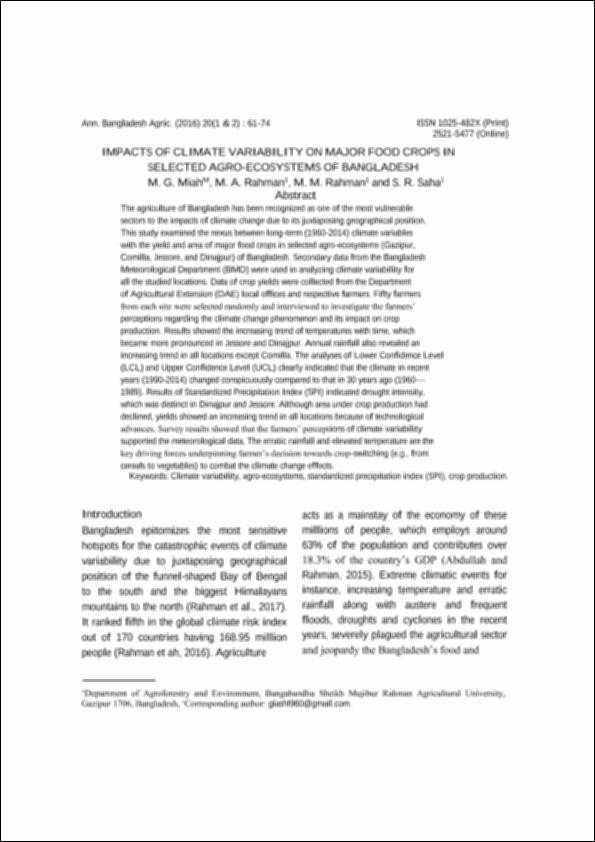| dc.contributor.author | Miah, M. G. | |
| dc.contributor.author | Rahman, M A | |
| dc.contributor.author | Rahman, MM | |
| dc.contributor.author | Saha, S. R. | |
| dc.date.accessioned | 2021-08-12T04:45:53Z | |
| dc.date.available | 2021-08-12T04:45:53Z | |
| dc.date.issued | 2016-12 | |
| dc.identifier.uri | http://publications.bsmrau.edu.bd/handle/123456789/1222 | |
| dc.description.abstract | Abstract :
The agriculture of Bangladesh has been recognized as one of the most vulnerable
sectors to the impacts of climate change due to its juxtaposing geographical position.
This study examined the nexus between long-term (1960-2014) climate variables
with the yield and area of major food crops in selected agro-ecosystems (Gazipur,
Comilla, Jessore, and Dinajpur) of Bangladesh. Secondary data from the Bangladesh
Meteorological Department (BMD) were used in analyzing climate variability for
all the studied locations. Data of crop yields were collected from the Department
of Agricultural Extension (DAE) local offices and respective farmers. Fifty farmers
from each site were selected randomly and interviewed to investigate the farmers’
perceptions regarding the climate change phenomenon and its impact on crop
production. Results showed the increasing trend of temperatures with time, which
became more pronounced in Jessore and Dinajpur. Annual rainfall also revealed an
increasing trend in all locations except Comilla. The analyses of Lower Confidence Level
(LCL) and Upper Confidence Level (UCL) clearly indicated that the climate in recent
years (1990-2014) changed conspicuously compared to that in 30 years ago (1960—
1989). Results of Standardized Precipitation Index (SPI) indicated drought intensity,
which was distinct in Dinajpur and Jessore. Although area under crop production had
declined, yields showed an increasing trend in all locations because of technological
advances. Survey results showed that the farmers’ perceptions of climate variability
supported the meteorological data. The erratic rainfall and elevated temperature are the
key driving forces underpinning farmer’s decision towards crop-switching (e.g., from
cereals to vegetables) to combat the climate change effects. | en_US |
| dc.description.sponsorship | BSMRAU | en_US |
| dc.language.iso | en | en_US |
| dc.publisher | BSMRAU | en_US |
| dc.relation.ispartofseries | Vol-1 & 2; | |
| dc.subject | Climate variability | en_US |
| dc.subject | agro-ecosystems | en_US |
| dc.subject | standardized precipitation index (SPI) | en_US |
| dc.subject | crop production | en_US |
| dc.title | Impacts of climate variability on major food crops in selected agro-ecosystems of bangladesh | en_US |
| dc.type | Article | en_US |

